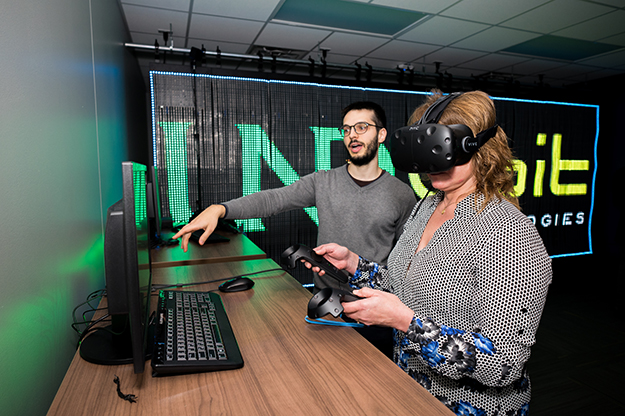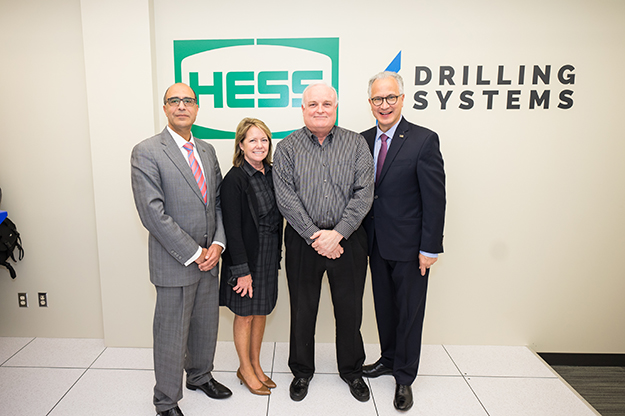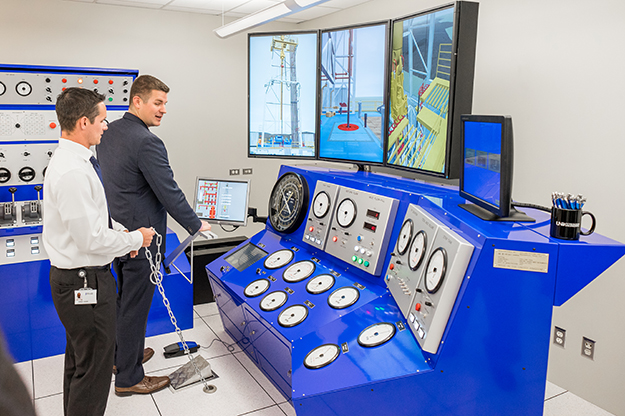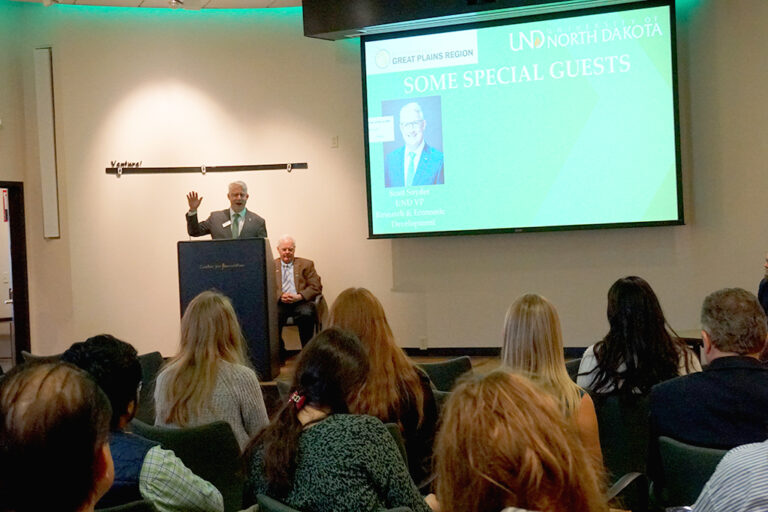Virtual view
New laboratories from industry partners bring the Bakken to UND petroleum engineering students

A little help from friends is bringing the Bakken oil fields to petroleum engineering students at UND.
From the squeal of the drill as it powers through shale to experimenting with new extraction technology, four new labs offer students hands-on experience at the Collaborative Energy Complex.
A grand opening Thursday, Oct. 12, let oil executives, state legislators and other dignitaries experience the labs themselves.
They flooded the labs as they took the helm of drill controls, tried out virtual reality goggles that took them to oil rigs, and “tested” samples, commenting on how much engineering education has changed.
They were wowed by the technology, which brings virtual oil fields, about six hours away in the Bakken of northwestern North Dakota, to campus.
The Hess/Drilling Systems Drilling Simulator Lab features a control panel and levers that replicate a real drill-floor environment in exacting detail, along with screens that mirror the actual drilling field. As executives began “drilling,” many commented on how close the experience is to reality.
Reality is the goal of the Hess Virtual Reality Lab, which uses 3-D goggles and screens to simulate working on a real rig, impressing visitors with true-to-life details.
The Hess Innovation Lab allows students to study shale drilling, and the Hess Teaching Labs enable students to learn petroleum engineering basics and conduct experiments to develop new drilling technologies.

Inviting innovation
“Our goal is to be the chief opportunity engine in North Dakota,” said UND President Mark Kennedy. “These labs allow students to help advance energy further. Research and experiential learning are core to our strategic plan.” Kennedy also mentioned that UND has recently been named by US News & World Report as one of the top 25 most innovative universities. “Labs like this keep us innovative.”
“It’s a special day for the College of Engineering and Mines and petroleum engineering program,” said Dean Hesham El-Rewini. He thanked industry partners for their contributions: “As you walk around the building, you see the names of friends which symbolize the collaboration between our partners.”
Many of those partners were present, and are members of the Petroleum Engineering Industry Advisory Council, a group of oil executives who support the petroleum engineering department and foster innovation.
Who’s Who in engineering
“The Petroleum Engineering Industry Advisory Council (IAC) is a ‘Who’s Who in Engineering,’” said Grant McGimpsey, vice president for research and economic development. He added that the IAC will help UND reach two important goals: increase retention and graduation rates and increase research. “This is a great way to achieve those goals.”
“It’s been about seven or eight years since we first started the IAC,” said Will Lehman, director of geological science and engineering development for Hess Corporation in Houston and who recently rotated off the IAC. “We laid out a plan, and formed a partnership with common objectives, and we hope to continue.” Lehmann later said that Hess has been in North Dakota since 1951, and sees great value in having engineers who are educated in North Dakota and have opportunities to remain in the state.

Offering opportunity
“There is a lot of industry support for this department,” said Matt Jurgens, vice president of operations for Zarvona Energy, chair of the IAC and a 2005 graduate. “You have a world-class resource here and a great opportunity for students to learn. We want to provide the best resources and attract top students. These labs bring the oil field to the students.”
“We don’t compete with other petroleum engineering programs,” said Vamegh Rasouli, chair of the department. “We are different. Shale drilling is number one for us, and our facilities are unique, thanks to our partners.”
“This is just the first stage of what is possible,” said Euan Kennedy, business development manager for Drilling Systems in Texas. “We are bringing world technology to oil and gas research.”


